COSMIC
HOT INTERSTELLAR PLASMA SPECTROMETER (CHIPS) SATELLITE
 |
| 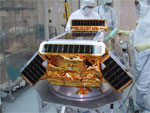 |
| Image
1 | | |
In
our galaxy alone, there are several hundred billion stars. Nearby stars are easy
to see, although most of the stars in the Milky Way are so distant that their
combined light appears as a fuzzy band stretching across the sky on a clear night.
Equally easy to see is the space between the stars -- but how often do you wonder
about this space? Most of us have an idea that these vast spaces are empty, a
perfect vacuum. In fact these space are filled with a very thin gas and microscopic
grains of dust. The material between the stars is known as the Interstellar Medium,
or ISM, and contains important clues about the formation and evolution of galaxies.
The Cosmic Hot Interstellar Plasma Spectrometer (CHIPS) satellite will give scientists
invaluable information on the origin, physical processes and properties of the
hot gas in the nearby interstellar medium. CHIPS is scheduled to launch as a secondary
payload to ICESAT aboard a Delta II rocket on January 11, 2003.
 |
| 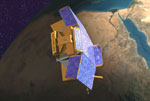 |
| Image
2 | | Click
on image for animation. | CHIPS
IN SPACE - The next three images/animations show the CHIPS satellite as it
rockets through space. The
CHIPS satellite will examine the "empty" space between stars called
the interstellar medium. This empty space is filled with gas and dust. CHIPS is
the first mission to use end-to-end satellite operations via the Internet. Credit:NASA
| | | | |
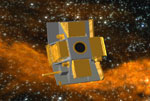 |  | 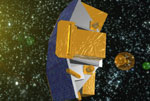 |
| Image
3 | | Image
4 | | Click
on image for animation. | | Click
on image for animation. | INTERSTELLAR
MEDIUM (ISM) IMAGES - These images of the Interstellar Medium were taken by
NASA's Hubble Space Telescope and are used to demonstrate the type of science
that CHIPS will study.
 |
| 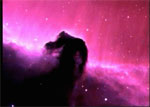 |
| Image
5 | | | Horsehead
Nebula - The dark area in the center of the image is a thick cloud of interstellar
dust blocking the light. Thinner clouds of interstellar dust may dim the light
passing through, without completely blocking it.
 |
| 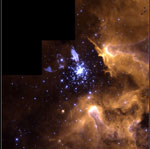 |
| Image
6 | | | Sher
25, NGC 3603 - The upper left center of the image is the evolved clue supergiant
called Sher 25. Near the center is a starburst cluster dominated by young, hot
stars. Dark clouds at the upper right are so-called Bok globules, which are probably
in an earlier stage of star formation. The gold colored clouds are ionized hydrogen
gas in the ISM.
 |
| 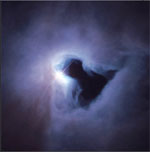 |
| Image
7 | | | NGC
1999 Nebula in the Constellation Orion - Light from nearby stars can be reflected
from interstellar dust, similar to the way light from a car's headlights can reflect
off fog. This Hubble image shows a reflection nebula - a cloud of interstellar
gas and dust illuminated by and reflected light from the star it surrounds.
 |
| 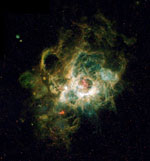 |
| Image
8 | | | Stellar
Nursery in Spiral Galaxy M33 - The hydrogen gas in the ISM can form relatively
cool clouds that emit light in the radio band of the electromagnetic spectrum.
-These cool clouds of hydrogen can collapse - it is here, in these dense collapsed
clouds known as stellar nurseries, that new stars are born. Back
to Top | 


